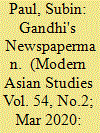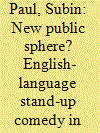| Srl | Item |
| 1 |
ID:
172008


|
|
|
|
|
| Summary/Abstract |
The expansion of the colonial public sphere in India during the 1930s and 1940s saw the nation's English-language press increasingly serve as a key site in the struggle for freedom despite British censorship. This article examines the journalistic career of T. G. Narayanan, the first Indian war correspondent and investigative reporter, to understand the role of English-language newspapers in India's quest for independence. Narayanan reported on two major events leading to independence: the Bengal famine of 1943 and the Second World War. Drawing on Michael Walzer's concept of the ‘connected critic’, this research demonstrates that Narayanan's journalism fuelled the Indian nationalist movement by manoeuvring around British censors to publicize and expand Mahatma Gandhi's criticism of British rule, especially in light of the famine and war. His one departure from the pacifist leader, however, was his support of Indian soldiers serving in the Indian National Army and British Army.
|
|
|
|
|
|
|
|
|
|
|
|
|
|
|
|
| 2 |
ID:
155743


|
|
|
|
|
| Summary/Abstract |
The genre of English-language stand-up comedy is increasingly becoming popular in India’s metropolitan cities. This study uses the concept of the public sphere to examine YouTube videos of a prominent Indian live comedian, Daniel Fernandes. The analysis shows that Fernandes’ verbal humor is based on several performative techniques such as linguistic code-switching, calculative pauses, and juxtaposition of incongruous things. The study, furthermore, demonstrates that English-language stand-up comedy extends the bourgeois public sphere by a satirical commentary on political, social, and cultural issues in contemporary India as well as internationally. The article also argues that the public sphere exemplified by the genre of English-language live comedy is not entirely new, but an advancement of the classical public sphere.
|
|
|
|
|
|
|
|
|
|
|
|
|
|
|
|